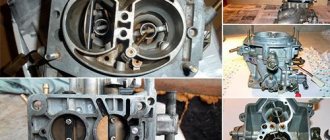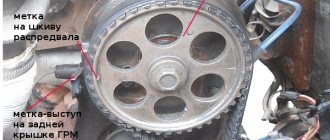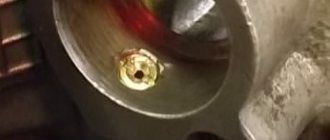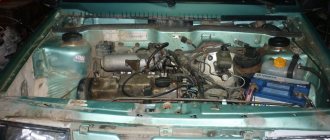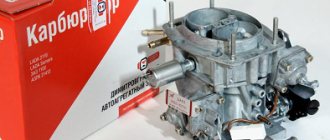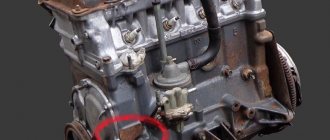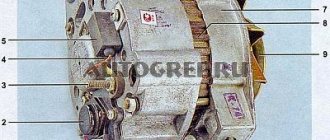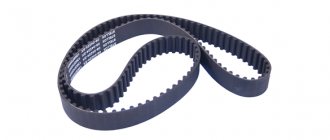The beloved “eight” by many
Having first appeared on the car market in 1984, the “eight” became a real “hit” of the Soviet automotive industry. The model successfully occupied the niche of family transport, youth hatchback, and even took part in sports rally raids. The car is still in service with DOSAAF sports clubs.
The VAZ 2108 model was successfully produced for almost 20 years, leaving the production line only in 2003. During this time, several different power units were installed on the car, including the VAZ 21083 engine. Characteristically, it had to be specially designed for a transverse arrangement, since “ Eight" was the first car with front-wheel drive in the territory of the former USSR. And at one time the share of such machines in the country was very large.
Characteristics of the base engine for the VAZ 2108
The front-wheel drive hatchback of the Volzhsky Automobile Plant had three doors, and with a total length barely exceeding 4 m (4006 mm), the weight of the car was only 915 kg. Given such technical characteristics and weight, the car could easily be accelerated by any engine. Over the long history of the car, several engines were installed on the VAZ 2108 model. Among the power units one could see:
Characteristics of motors for the G8
- derated 1.1 liter gasoline unit with a manual transmission with 4 gears;
- 1.3-liter engine, which was installed as the base power unit;
- the 1.5 liter engine had a carburetor version and a modification with an injector; a car with such an engine worked only in combination with a 5-speed manual transmission;
- as experimental models, the G8 was equipped with a 1.6 liter and 1.5 liter engine with a 16-valve gas distribution mechanism; These types of engines were transitional and subsequently began to be actively used on the VAZ 2110, Priora and other cars in the AvtoVAZ concern line.
A modification of model 2108 with a 1.1 liter engine was produced only at first, and subsequently became less and less common. The remaining engines appeared in the technical indicators of the car throughout the production of 2108. Engine 1300 cm³, technical data:
- type - gasoline, 4-cylinder;
- number of valves per cylinder - 2;
- compression ratio - 9.9;
- type of power system - carburetor;
- fuel used - AI-92;
- assembled engine weight - 127 kg;
- power - 64 l. With. at 5600 rpm;
- torque - 94 Nm at 3500 rpm.
The engine could confidently accelerate the car to 100-120 km/h with a maximum speed of 160. However, due to the low torque, when the weight of the 2108 increased, or when driving uphill, it “soured” very quickly, forcing it to switch to a lower gear. The 100 km/h mark was reached in 16 seconds. Engine 1500 cm³ (carburetor), technical data:
Under the hood of a car
- type - gasoline, 4-cylinder;
- number of valves per cylinder - 2;
- compression ratio - 9.9;
- fuel used - AI-92;
- power - 70 l. With. at 5600 rpm;
- torque - 106.4 Nm at 3500 rpm.
The VAZ 21083 model with a 1.5-liter engine was able to maintain “cruising” speed in fifth gear, which immediately affected fuel consumption. The car consumed up to 6 liters per 100 km, and in practice this was even more noticeable. After all, the driver could not spin the engine as much as the 1.3 liter engine required. Motor 1500 cm³ (injector), technical data:
- power - 78 l. With. at 5400 rpm;
- torque - 115 Nm at 3000 rpm.
The VAZ 21083 engine with direct injection not only made it possible to further increase power and torque, which was reflected in the traction and dynamic performance of the car. But the engine has also become a little more economical, but at the same time the emission of harmful substances into the atmosphere has decreased. The weight of the power unit, in comparison with the base one, does not differ significantly.
Over a long period of operation of engines for models 2108 and 21083, the main shortcomings of power units and their inherent technical malfunctions were identified.
Luggage weight depending on the number of passengers: 5 people. 50 kg. 2 people 275 kg.
Curb weight 900 kg. Gross weight 1,325 kg. Including: front axle 670 kg. on the rear axle 655 kg.
Permissible trailer weight: not equipped with brakes 300 kg. equipped with brakes 750 kg.
Max. Speed 148 km/h. Acceleration time to 100 km/h 16 s.
Mak s, gradeability 34%
| Run-out from 50 km/h 500 m. Braking distance from 80 km/h 38 m. Control fuel consumption, l/100 km: at 90 km/h in fifth gear 5.7 liters. at 120 km/h in fifth gear 7.8 liters. urban cycle 8.6 l. Turning radius: on the outer wheel 5.0 m. overall 5.5 m. |
Engine.
Maud. VAZ-2108, petrol, in-line, 4-cylinder.. 76×71 mm, 1.3 l, compression ratio 9.9, operating order 1-3-4-2, power 47.0 kW (63:7 hp. s.) at 5600 rpm, torque 94.0 N-M (9.6 kgf-m) at 3500 rpm. Carburetor 2108-1107010-78. Air filter - with automatic thermostat and replaceable filter element. Cooling system - with an electric fan that automatically turns on and off.
Transmission.
Combined into one unit, consisting of a clutch, gearbox and final drive with a differential. The clutch is single-plate, with a diaphragm spring, the release drive is cable. Gearbox: 5-speed, with synchronizers in forward gears. Send numbers: I-3.636, II-1.96, III-1.357, IV-0.941, V-0.784, ZX-3.94. The wheels are driven by shafts with constant velocity joints.
Wheels and tires.
Wheels - disc, stamped, rim 4 1/2J-13 for tube tires and 4 1/2-13H2 for tubeless tires. Tires - radial, low profile, tubed or tubeless, 155/80R13, 165/70R13 or 175/70R13.
Suspension.
The front is independent with telescopic hydraulic shock absorbers, coil springs, lower wishbones with braces and a stabilizer bar. The rear is on longitudinal interconnected arms, with coil springs and hydraulic shock absorbers.
Brakes.
Working brake system: front brakes - disc, rear - drum with automatic clearance adjustment. The drive is hydraulic, two-circuit in a diagonal pattern, with a vacuum booster and a brake force regulator. Parking brake - on the brake mechanisms of the rear wheels, cable drive. The spare brake is one of the circuits of the service brake system.
Steering.
The steering mechanism is rack and pinion.
Electrical equipment.
12 V. ac. battery 6ST-55A, generator 37.3701, voltage regulator 17.3702. starter 29.3708, ignition system - contactless with ignition coil 27.3705, electronic switch 3620.3734 and distribution sensor 40.3706. Spark plugs FE65P (Yugoslavia) or A17DV-10.
Filling volumes and recommended operating materials.
Fuel tank - 43 l, AI-93 gasoline; cooling system - 7.8 l. "Tosol" A-40; engine lubrication system - 3.5 l.; M-12G, at temperatures from + 35 to -10 °C; M-63/10G, at temperatures from +20 to -25 °C; M-53/10G, at temperatures from +30 to -30 °C; gearbox housing (5-speed) - 3.3 l; M-8GI at temperatures from 45 to -40 °C; M-12G at temperatures from +45 to -25°C; M-63/10G, and M-53/10G, at temperatures from +45 to -40°C; hydraulic brake system - 0.55 l, Rosa, Tom fluids; hydraulic front suspension struts - 2×0.25 l, MGP-10; rear shock absorbers - 2×0.32 l, MGP-10; shock absorbers - 2×0.25 l, MGP-1 2; windshield washer reservoir - 4.2 or 2.0 l, NIISS-4 liquid mixed with water.
Weight of units (in kg).
Complete engine, without clutch and gearbox - 82; gearbox with differential, fork and clutch release bearing - 34; complete body without upholstery and seats - 245; front suspension - 55; rear suspension - 45; wheel assembly with mud and camera - 14.3; wheel assembly with tubeless tire - 13.4.
Operation and repair of a factory engine
Factory engine can be improved
The 1.3 liter engine was the base engine for all models of the family. Among its features are the overhead camshaft and the use of a belt in the gas distribution mechanism drive. The factory service life for the engine was set at 120 thousand km before major repairs.
As practice has shown, this resource was successfully maintained, and with gentle operation and timely maintenance of the power plant, this figure increased to 200 thousand. Among the main malfunctions of the VAZ 2108 engine, a group of such problems can be identified. Lubrication system:
- oil leaks through the valve cover seals at the sensor installation site;
- the need for frequent oil changes.
The second feature is associated with the low quality of the produced oils, when the replacement interval of 10 thousand km could not be maintained. The lubrication system had a nominal volume of only 3.5 liters, so a 4-liter canister was enough to spare. Considering the low cost of the filter and oil, such a replacement did not cause any difficulties.
The carburetor needs frequent cleaning
Supply system:
- low reliability of the installed carburetor (usually Solex), which requires frequent adjustment and cleaning;
- high sensitivity to gasoline quality; if low-quality fuel was used, this could result in detonation in the engine, as well as the need to clean the carburetor.
Ignition system:
- interruptions in cylinder operation;
- sensitivity of spark plugs to low-quality fuel.
Cooling system:
- the appearance of leaks;
- wear on the water pump blades.
To summarize, it can be noted that the proportion of faults, in comparison with other VAZ engines, does not exceed normal values. High reliability and maintainability, the quality of their manufacture for their time is confirmed by the fact that many of them still work properly on the VAZ line of hatchbacks. Motors are repaired and modified, obtaining additional output from them.
VAZ 2108 engine
VAZ 2108 cars became a real breakthrough for the domestic automobile industry. The mass Soviet buyer has long wanted something more worthy than the same type of housing from the Zhiguli classic family. Therefore, in the late 70s, designers were given the task of developing a revolutionary model.
The notorious golf class was taken as a basis (and specifically in the form of a Volkswagen Golf). Porsche engineers were invited as consultants. When discussing the layout - a front-wheel drive small-class hatchback, experts calculated a typical engine. The most suitable engine model for the VAZ 2108 was the four with a volume of 1300 cm³.
It is interesting that the VAZ 21011 engine model of the same volume did not fit the specifications. On the recommendation of colleagues from Porsche, the VAZ 2108 engine was developed from scratch. Volume, dimensions, characteristics were adjusted to the new body immediately during design. Therefore, the car + engine set turned out to be very progressive for its time.
By the time the first production car was released, this particular engine became the base engine for the VAZ 2108. A few years later, a volume of 1500 cm³ was added to it, and then 1100 cm³.
Engine VAZ 21083-1000260-53. Characteristics of the VAZ 21083 engine.
The engine is four-stroke, carburetor, in-line, with an overhead camshaft. The engine cooling system is liquid, closed type, with forced circulation of liquid. The engine has a combined lubrication system: pressure and splash.
| Number of cylinders: | 4 |
| Cylinder displacement, l: | 1,5 |
| Compression ratio/gasoline: | 9.9 / AI 93 |
| Rated engine power at a crankshaft speed of 5600 rpm: | 49.8 kW.-(69 hp) |
| cylinder diameter, mm: | 82 |
| Piston stroke, mm: | 71 |
| Number of valves: | 8 |
| Minimum crankshaft speed, rpm: | 750-800 |
| Maximum torque at 3500 rpm, N*m: | 106,4 |
| Cylinder operating order: | 1-3-4-2 |
| Octane number of gasoline: | 92-95 |
| Fuel supply system: | carburetor |
| Ignition system: | Contactless |
| Spark plug: | A17DVRM, FE65CPR |
| Weight, kg: |
Engine Features. Technical data
Designed for installation on VAZ models: 2108, 21083, 2109, 21093, 21099, 2113, 2114, 2115 and their modifications.
The VAZ 21083 engine, like its predecessor, the VAZ 2108 engine, was specially designed for transverse placement in the engine compartment of a car.
The cylinder block 21083 is made with a cylinder center size of 89 mm. The overall dimensions of block 21083 correspond to the dimensions of block 2108. (See “Cylinder block”) The height from the axis of the crankshaft to the upper surface of the block is 194.8 mm. They differ in the diameter of the cylinders. On block 21083, the cylinder diameter was increased to 82.00mm. The class of the cylinder is indicated in Latin letters and marked on the bottom surface of the block in accordance with the dimensions of the cylinder diameter. The design of the unit does not provide for the possibility of using a drive shaft for auxiliary units.
The engine is equipped with a crankshaft model 2108-1005016. The radius of the crank shaft is 35.5mm. (piston stroke – 71mm.). The diameter of the generating circle of the counterweights is 131 mm, the width of the counterweight cheek is 102 mm, the diameter of the connecting rod journal is 47.83 mm. There is no marking on the shaft.
A new piston is used. Piston – 21083-1004015. A new piston design was used, developed with the help of the German companies Porsche and Kolbenschmidt. Unlike pistons for 2106 and 2103, they are not coated with a layer of tin. On “German” pistons, a special microprofile is used on the side surfaces of the piston. This micro-profile allows you to retain lubricant under any engine operating conditions. Repair dimensions of pistons - 82.4 mm; 82.8mm.
The piston pin is used mod. 21213. When installed, it is pressed into the upper head of the connecting rod, but ensures free rotation in the piston bosses. The piston pin has a length of 67mm, diameter of 22mm.
New rings with a diameter of 82 mm are installed on new pistons. The height of the rings remained the same: the first compression ring – 1.5 mm; second compression – 2mm; oil scraper -3.95mm. Oil scraper ring – chrome plated. Set designation for normal size is 21083-1000100-10. It is possible to install steel piston rings 21083-1004029.
Connecting rod - 2108-1004045. The length of the connecting rod is 121mm. Connecting rods 2108 (2110) are heavier than connecting rods 2101 (21213). The upper head of the connecting rod is made more massive. The tides on the upper head are made on both sides.
Flywheel 2108-1005115. The diameter of the surface for the clutch is 196 mm. The width of the flywheel crown is 20.9 mm.
The engine received a new cylinder head 21083. The diameters of the intake valves were changed (from 35mm to 37mm). Optimization of the fuel combustion process made it possible to increase the compression ratio to 9.9.
Camshaft - 2108-1006015. It should be distinguished from camshaft 21081. On the shaft 21081-1006015 there is a raw cylindrical belt between the third and fourth cams. At the rear of the camshaft there is an eccentric that drives the fuel pump.
Maintenance and repair
The motor was designed by domestic engineers, so the owner with basic equipment maintenance skills can disassemble and reassemble the unit. Repair of the VAZ 2108 engine takes place in garages, or, in extreme cases, at inexpensive universal services.
It makes no sense to consider individual components; it would be more correct to describe a typical overhaul. The dimensions and weight of the VAZ 2108 engine allow it to be removed from the engine compartment with a conventional winch.
Important! If there are burrs in the crankshaft group, check the oil channels. The reason for increased wear is oil starvation.
If there is no need to gain access to the crankshaft, the rest of the repairs can be done directly in the car. The engine model and the volume of the engine compartment allow.
Features of the new power plant
The block was cast from cast iron, which gave a good margin of safety. A typical technical solution is an overhead camshaft. This made it possible to fit a tall block into the small size of the hood space. Model 2108 claimed a reduced drag coefficient. The engine had a timing belt, which was quite easily changed by the owner himself.
The dimensions were influenced by reduced connecting rods, valve length, and a convenient location of the water pump. And the oil pump was located directly at the end of the crankshaft. The combustion chamber of an original shape and a compression ratio of 9.9 provides good efficiency. The geometry reduces resistance to the movement of the air-fuel mixture. The honing is modeled after the best cars of those years. An example was the Porsche engine.
The manufacturer installed the VAZ 2108 engine with a volume of 1300 cm³, a service life of 120 thousand km. However, with normal care, the service life could be extended. With a good owner, the between-repair mileage of a VAZ 2108 internal combustion engine could reach 200 thousand km, unprecedented for the domestic automobile industry.
It is not known whether Porsche engineers are to blame for this, but the engine was very sensitive to the quality of gasoline. By filling up the cheaper 92nd, the owner of the VAZ 2108 could easily “screw up” the engine block with constant detonations. But on a high-quality ninety-five (early AI-93), the engine pulled the light eight like a feather.
The basic model of the engine for the VAZ 2108 turned out to be so reliable and durable that today you can find copies of 1985 in excellent condition.
Technical characteristics and design of the 1300 cm³ engine
The cylinder block and crankshaft are cast iron. The lubrication system operates through through holes. The flywheel is single-mass and has a lot of weight for a motor of this size. The connecting rods, pins of a simple design, are made of steel. This model, due to its safety margin, is often used in sports versions. The walls of the cylinder block are steel, the pistons are cast from aluminum.
The design of the motor of this model is shown in the illustration:
